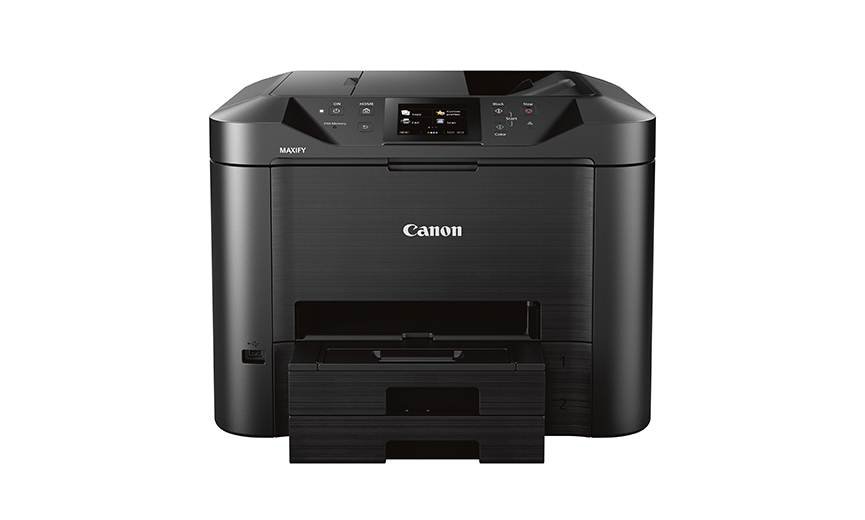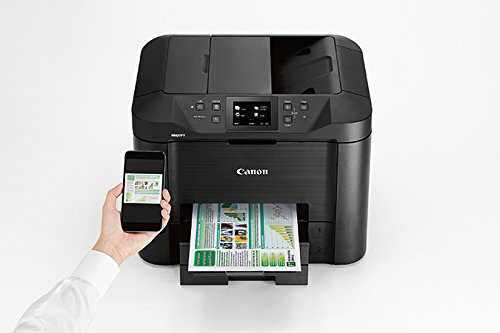Tom's Guide Verdict
High image quality, fast printing and quick copying — both one-sided and two-sided — make the MB5420 a great fit for a small office in need of a bargain all-in-one.
Pros
- +
Fast printing and copying
- +
Two-sided scanning/copying from document feeder
- +
Two 250-sheet paper trays
- +
Speedy startup
Cons
- -
Slow scanning to PDF
- -
Standard ink cartridges are expensive
- -
4-by-6-inch photo paper limited to 20 sheets
Why you can trust Tom's Guide
At $300, the Canon Maxify MB5420 offers business-worthy features at a down-to-Earth price. It's expensive for a home printer, but it's such a solid bargain compared to many other business models that we awarded it our Editor's Choice as the best printer for small business.
The MB5420 is outfitted with two paper trays, which can hold a total of 500 sheets. Using the 50-sheet document feeder, the unit can simultaneously scan both sides of a two-sided document, which the duplexer can then make into two-sided prints. The MB5420 is built for heavy use, with a monthly duty cycle of 30,000 pages. To help lower printing costs, high-yield ink cartridges are available, which could cut printing costs roughly in half.
The Maxify MB5420 offers wireless connectivity, an Ethernet port and a USB port for printing from a PC. And there's a USB flash memory port for printing from a thumb drive. You can save up to 100 numbers for speed dialing with the fax function.
Design
The control panel is fixed at an angle. In the center, there is a 3.5-inch color touch screen, which you use to make most menu selections. Like with a smartphone touch screen, you can swipe the menu icons across the screen. Easing operation are five physical buttons: Home, back, stop, and two start buttons for black-and-white print/copy and color print/copy.

This model is neither a behemoth nor extremely petite. Its footprint is roughly 18 inches wide by 18 inches deep. It is nearly 14 inches tall, and you need a little bit of vertical clearance to accommodate lifting up the document feeder. By comparison, the HP OfficeJet 7720 has roughly the same depth but is 23 inches wide. The Brother MFC-J775DW is the smallest of the three, at 16.5 inches wide.
Each of the MB5420's paper trays can hold up to 250 sheets of plain paper. The upper tray can be adjusted to hold up to 20 sheets of photo paper.
Get instant access to breaking news, the hottest reviews, great deals and helpful tips.
Print Speed
The Maxify MB5420 turned in impressive performance in our tests. It churned out a five-page text document in 17.1 seconds, for a rate of 17.5 pages per minute. This was significantly faster than the HP OfficeJet 7720 and the pricier Epson WorkForce Pro WF-6590, both of which were significantly slower, at more than 24 seconds (or, 12.3 and 12.2 ppm, respectively).
Perhaps the best news on print speeds is that the Maxify printer's duplexer does not compromise performance much. The MB5420 printed two-sided text documents at 11.7 ppm. The HP OfficeJet 7720 was a little slower at this task, achieving a rate of 10.2 ppm.

Our mixed text and color graphics document printed in about 1 minute, for a rate of roughly 6 ppm. The HP OfficeJet 7720 was a few seconds faster (6.4 ppm), while the Epson WorkForce Pro WF-6590 was just half a second slower (5.9 ppm) than the Canon. The pricy HP PageWide Pro 577dw, meanwhile, almost cut the Canon's time in half, printing the same six pages in just 31.6 seconds.
The Canon printed the graphics document two-sided at 4.1 ppm. The OfficeJet 7720 did so at a slower 3.5 ppm.
The MB5420 printed a glossy photo on letter-size paper in 2 minutes 5 seconds. The HP OfficeJet 7720 made the same glossy print in 1 minute 41 seconds.
Copy and Scan Speed
The Maxify MB5420 made a black-and-white copy quickly, in just 7.6 seconds. The Epson WF-6590 was quicker, at 6.2 seconds, while the HP 7720 was significantly slower, at 15.3 seconds. The best news here is that the MB5420's document feeder is quick. Rather than slowing down copy speed, the feeder actually sped it up, enabling the unit to make a black-and-white copy in 7.1 seconds.
When using the duplexer to make two-sided copies of a one-sided original text document, the MB5420 copied five pages in 34.2 seconds, or at 8.8 ppm. The OfficeJet 7720 was slower, at 5.4 ppm.

Similarly, the MB5420's document feeder slowed down color copying only slightly. The MB5420 made a color copy in 13.4 seconds, with the document placed on the glass. When the original was fed through the document feeder, the MB5420 made a copy in 13.9 seconds. The HP 7720 was a little slower, at 16.8 seconds, while the Epson WF-6590 was twice as fast, making a color copy in just 6.7 seconds.
The MB5420 made a 600-dpi scan to JPEG format in 31.7 seconds. The Epson WF-6590 was slightly faster, at 30.9 seconds in color. The MB5420 was relatively slow to make a 300-dpi black-and-white PDF, doing so in 9.4 seconds. The HP 7720 was significantly faster on this test, turning in a time of 5.8 seconds.
The MB5420 can simultaneously scan both sides of a two-sided document. Without this ability, copying two-sided documents would be laborious. You'd have to manually flip over each page and copy one page at a time. Using the document feeder, the printer scanned a 10-page color document (5 sheets) in 38.1 seconds.
Print Quality
The Maxify MB5420 makes attractive text prints, with dark, crisp letterforms that are nearly laser quality. That quality did not diminish in two-sided prints. Graphics printed with sharp details and smooth textures, along with bold, dark shades. Colors looked natural, and midtone transitions were smooth.
MORE: Best All-in-One Printers of 2017
Glossy photos were very attractive, with fine details and smooth textures. Colors looked natural and were well-saturated.
Similarly, copies of text documents retained nearly all of the sharpness of the originals, with letterforms that looked only slightly lighter than those in the original documents. Copies of graphics also looked very close to the originals, with bold darks, accurate colors and details that looked almost as sharp as in the originals. Also, the smoothness of textures was reproduced well.
Ink Cost and Yield
Using standard cartridges, ink costs are above the average, at 3 cents for black and 13.5 cents for color. By comparison, standard-yield costs for the HP OfficeJet 7720 are 2.1 cents and 11.1 cents, respectively.
High-yield cartridges, however, put the MB5420's ink costs in line those of with the field, with estimated costs of 1.5 cents (black) and 7.1 cents (color), versus 2.1 cents and 8.1 cents, respectively, for the HP OfficeJet 7720. These costs are computed with standardized page yields and individual ink-cartridge prices. Buying multipacks of cartridges should lower ink costs. Only the Brother MFC-J775DW turned in demonstrably lower ink costs in this category, with estimated costs of 1 cent (black) and 4.3 cents (color) using high-yield cartridges.

Setup and Software
The Maxify MB5420 is easy to set up and offers no surprises. After you remove some tape used to protect the unit during shipping, setup is intuitive and the instructions are easy to follow. Setting up Wi-Fi is simple using the WPS method, in which you press the WPS button on your wireless router to initiate the connection, without having to enter your network password. Thereafter, the MB5420 starts up in a brisk 5.6 seconds or so.

The printer comes with setup CD-ROM with a print driver and software for scanning and faxing. These are also available for download from the product page on the company website. In addition, there is PosterArtist Lite (Windows only) for designing graphics, and a network tool.
Bottom Line
The modestly priced Maxify MB5420 has a lot to offer a small office in need of a workhorse. This printer earned our Editors' Choice for many reasons, including the generous assortment of features, such as a document feeder, two-sided copying/scanning and 500-sheet paper capacity. Performance is solid across the board, particularly for office duties. Text printing was significantly faster than on most other models, and black-and-white copying, for example, was twice the speed of that for the HP OfficeJet 7720. In addition, image quality is top-shelf. If you use high-yield ink cartridges, printing costs will be on a par with those for the competition.
Image Credit: Canon
Eric Butterfield is a freelance writer and musician from California. His work has appeared in PC World magazine, CNET, Taproot, and Alter Action — plus Tom's Guide, of course — while his music has appeared in more than 260 TV show episodes for major networks such as NBC, Hulu, BBC America, and more. You can check out his work on Spotify.
